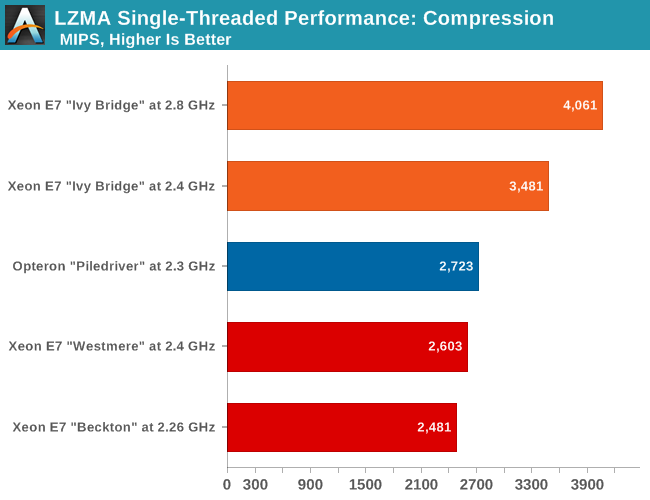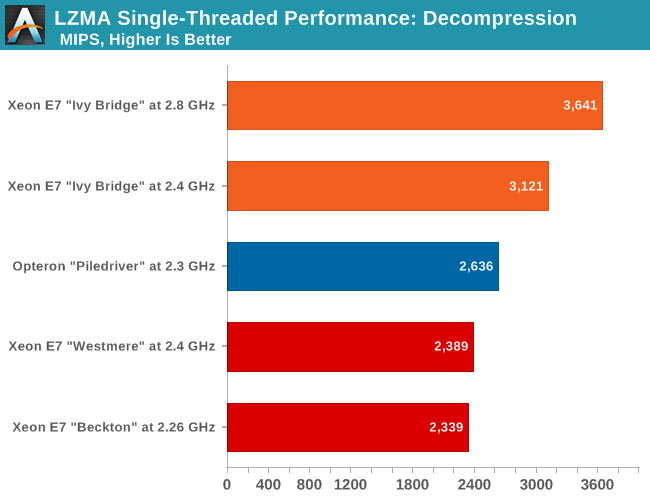The Intel Xeon E7 v2 Review: Quad Socket, Up to 60 Cores/120 Threads
by Johan De Gelas on February 21, 2014 6:00 AM EST- Posted in
- IT Computing
- Intel
- Xeon
- Ivy Bridge EX
- server
- Brickland
Single-Threaded Performance
I admit, the following two benchmarks are almost irrelevant for anyone buying a Xeon E7 based machine. But still, we have to quench our curiosity: how much have the new cores been improved? There is a lot that can be said about all the sophisticated "uncore" improvements (cache coherency policies, low latency rings, and so on) that allow this multi-core monster to scale, but at the end of the day, good performance starts with a good core. And since we have listed the many subtle core improvements, we could not resist the opportunity to check how each core compares.
The results aren't totally meaningless either, as the profile of a compression algorithm is somewhat similar to many server workloads: hard to extract instruction level parallelism (ILP) and sensitive to memory parallelism and latency. The instruction mix is a bit different, but it's still somewhat similar to many server workloads. And as one more reason to test performance in this manner, the 7-zip source code is available under the GNU LGPL license. That allows us to recompile the source code on every machine with the -O2 optimization with gcc 4.8.1.
We've run an additional data point for this particular set of tests. The new Ivy Bridge EX was tested at 2.8GHz and downclocked to 2.4GHz, so that we can do a clock-for-clock comparison with Westmere EX. Since we're only testing single-threaded performance here, other than perhaps slight differences due to having more total L3 cache, it doesn't matter which particular E7 v2 chip we use.

The latest Xeon E7 v2 "Ivy Bridge EX" is capable of extracting 33% more ILP out of the complex compression code than the older Xeon E7 "Westmere-EX" at the same clock speed. That is pretty amazing and shows how all the small micro-architecture improvements have accumulated into a large performance increase. The Opteron core is also better than most people think: at 2.4GHz it would deliver about 2481 MIPs. That is about 80% of Intel's best server core at the moment—not enough, but nothing to be ashamed about.
Also interesting to note is that the Westmere core was indeed a "tick": any performance increase over the Xeon X7560 (Codename "Beckton", 45nm Nehalem core) is simply the result of the higher clockspeed of the 32nm chip.
Let us see how the chips compare in decompression. Decompression is an even lower IPC (Instructions Per Clock) workload, as it is pretty branch intensive and depends on the latencies of the multiply and shift instructions.

Again, we note a 30% improvement in integer performance going from the Xeon E7 "Westmere" (Xeon E7-4870 at 2.4GHz) to the Xeon E7 v2 "Ivy Bridge EX" (Xeon E7-4890 v2 clocked down to 2.4GHz).
To summarize: the new 15-core Xeon E7 v2 is built upon a strong core architecture that has improved significantly compared to the predecessor.










125 Comments
View All Comments
colonelclaw - Monday, February 24, 2014 - link
I would like to see V-Ray benchmarked. It's fast becoming an industry standard across a number of 3D industries (started in ArchVis, is now moving into animation feature films and FX)PowerTrumps - Sunday, February 23, 2014 - link
The author is misleading with statements and data not to mention @Brutalizer comes across very knowledgeable but only backs up claims or Oracle server performance with platitudes and boasts.Starting with the article - comparing various cores regardless if you adjust the frequency is misleading. You need to normalize the values to show what the per core improvement is. To stay with sockets is useless and lazy. Yes, Intel customers buy servers by the socket but to understand what they are really gaining this is a much better metric. To say there is a 20 or 30% gain when there might be 50% more cores tells me the per core performance is actually lower than Westmere. This is important when using software like Oracle that would price a 15 core socket at 7.5 or 8 Oracle licenses. For software licensed by the core, customers should demand the highest performance available otherwise all you do is subsidize Uncle Larry's island. For the Power comparisons in the SAP benchmarks. You compare a 60 core to a 32 core N-1 generation Power7 server. Since Power servers scale almost linearly by frequency, the 8 core @ 4.22 GHz is 54,700. If we extrapolate that to a 4 socket or 32 cores we would be around 200K SAPS. That is quite a bit more than the 60 core Dell. Also, you could deploy a Power server as a standalone server. Nobody would deploy a mission critical workload on a standalone x86 server. Yes, I'm sure somebody will argue with me and say they do and have done it for years. Ok, but by and large we know they are always clustered and used to scale-out. Secondly, you claim how expensive the Power servers are. When was the last time you priced one Mr De Gelas? You can get a Power7+ 7R1, 7R2, or 7R4 that has price parity with a typical x86 price that includes Linux and VMware and comparably equipped. The 710 and 730 servers would be just a bit more but definitely competitive. Factor in the software savings and reduction in the number of servers required and the TCA and TCO will favor Power quickly. I do it all of the time and can back it up with hard data. You can run Power servers up to 90% utilization but rarely run x86 over 30%, maybe 35% tops.
With regard to @Brutalizer - Big claims of big servers, up to 96 TB of RAM. Who needs that? Who needs a server with 100's or 1000's of cores? The Oracle M6-32 has 1000 DIMMs to get 32 TB of memory. Tell us how this influences the MTBF of the server since the number of components is a major factor in the calculation. Next, you scoff at IBM for comparing to older servers. That is because they are talking to customers who are running older servers - consolidate those older servers onto a few or just 1 server that is inherently reliable - nothing more than a IBM mainframe followed by a IBM Power servers. Oracles M6-32 and M5-32 are just cables T5 servers scaled back from 16 to 12 cores. They have little RAS and built for marketing hype and to drive Oracle software licensing revenue. You say the Oracle M processor pricing is X and then try to paint picture that Power servers are more expensive for a 32 socket than a 8 socket - really. A v8 luxury car is more expensive than a 4 cyl econobox. The server price is moot when the real cost is the software you run on it. With Oracle EE + RAC at $70,500 + 22% annual maintenance per core it matters. On Power I only have to license the cores I need. If I need 2 cores for Oracle then I license 2 cores. On x86, the 15 core is 8. (15 x .5 = 7.5 rounds to 8). Oracle M series is also .5 so your 128 cores on SAP S&D to my 64 co Power7 at 1.0 puts us about equal. However, most customers don't run the servers with one workload. You will say your LDOMs is efficient but compared to Power Hypervisor it won't hold a candle to efficiently using the cores and threads - all of them in true multi-thread fashion. With Power8 coming out soon both Intel and Oracle will go back to smelling the fumes of Power servers. To customers out there. It isn't about being Ford or Chevy. This isn't college - don't root for your team even when they are no good. Your business has to not only survive but hopefully thrive. Do that on a platform that controls the largest cost which is software and Full Time Equivalents - that is Power servers.
Phil_Oracle - Monday, February 24, 2014 - link
Well I must say that this article is clearly Intel biased with a lot of misleading and downright wrong statements about Oracle and SPARC. Heres some accurate and substantiated counters:"Sun/Oracle's server CPUs have been lagging severely in performance"
This is wrong, considering that since the SPARC T4 release, and now SPARC T5 and SPARC M6 announcements, Oracle has announced 20+ world record benchmarks across *all* of the public, audited benchmarks from TPC-C, TPC-H @ 1TB, 3TB, 10TB to SPECjEnterprise2010 and SPECjbb2013. Many of them are still valid today, almost a year later.
What I'd like to ask, is where are the 8-socket Xeon E7 v2 benchmarks to compare to SPARC? Theres only one today - SAP. And this doesn’t demonstrate database performance nor java application performance.
Theres also no 4-socket or 8-socket benchmarks on TPC-C, TPC-H, SPECjEnterprise2010.
Even with SPECjbb2013, theres just a 4-socket result, and if you compare performance/core, the SPARC T5-2 @ 114,492 max-jOPS (just 32-cores) has a 1.3x performance/core advantage over the NEC Express5800/A040b with 60 x Intel E7-4890 v2 2.8 GHz cores @ 177,753 max-jOPS.
"As usual, the published benchmarks are very vague and are only available for the top models "
As of today, there is not a single real world application/database benchmark that shows Xeon having superior throughput, response times or even price/performance comparing systems with same # of CPUs to SPARC T5. You can go here to see all the comparisons with full transparency. https://blogs.oracle.com/BestPerf/
"and the best performing systems come with astronomic price tags ($950,000 for two servers, some networking, and storage... really?)."
You do realize you are linking to Oracle Exadata which isn't a server but an Engineered system with many servers, storage and networking all built-in and based on XEON??
Why are you not linking to SPARC T5 server pricing which is here since that’s what you are trying to discredit? Heres the SPARC T5-2 pricing which is very aggressively priced to x86 & IBM Power7+ systems.
https://shop.oracle.com/pls/ostore/f?p=dstore:5:90...
Or better yet, look at a public benchmark where full HW and SW pricing is disclosed?
A SPARC T5-4 is 2.4x faster than the 8-socket Xeon E7-4870 based HP DL980 G7 on TPC-H at 10TB.
The SPARC T5-4 server HW fully configured costs $268,853, HP DL 980 costs $268,431.
Basically same costs, SPARC T5 is 2.4x faster than Westmere-EX. Wheres Xeon E7 v2 to showcase its 2x faster??
Details of pricing and results are here.
http://www.tpc.org/tpch/results/tpch_result_detail...
http://www.tpc.org/results/individual_results/orac...
http://c970058.r58.cf2.rackcdn.com/individual_resu...
On TPC-C OLTP benchmark, a SPARC T5-8 has a $/perf of .55USD/tpmC, versus fastest Oracle x2-8 of .89 USD/tpmC and IBM x3850 of .59USD/tpmC. SPARC T5-8 is 70% faster per CPU than Westmere-EX based Oracle x2-8. http://www.tpc.org/tpcc/results/tpcc_results.asp?o...
Haravikk - Tuesday, February 25, 2014 - link
I wouldn't mind a 60 core Xeon in the next version of Apple's Mac Pro ;)Desert Dude - Thursday, April 3, 2014 - link
Interesting discussions. Just for clarification, there is an x86 server that goes beyond 8 sockets-bullion (Xeon E7 48xx up to 16sockets with near linear scale). Bull (legacy GE & Honeywell Mainframe) has leveraged technology used in its mainframe & HPC to build bullion...the world's FASTEST x86 server. bull.us/ bullion